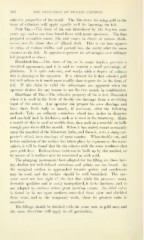Page 298 - My FlipBook
P. 298
296 THE OPEIIATION OF FlIAJNd CAVITIES.
cohesive properties of the metal. Tlie directions lor using gold in the
form of cylinders will apply equally well ibr inserting tin foil.
Felt Tin.—This form of tin was introduced by Dr. Slayton some
years ago, and at one time found favor with many operators. Tin thus
prepared resembles coarse felt, and comes in sheets of various thick-
nesses, usually about that of billiard cloth. This is cut into squares
or strips of various widths and packed into the cavity after the same
manner as tin foil. It appears to possess no advantages over ordinary
foil prepared as above.
Shredded Tin.—This form of tin, as its name implies, presents a
shi-edded appearance, and it is said to contain a small percentage of
platinum. It is quite cohesive, and works with a degree of softness
that is pleasing to the operator. It is claimed for it that cohesive gold
foil will adhere to it much more readily than to pure tin in the form of
foil. If this claim be valid the advantages are apparent when the
operator desires for any reason to use the two metals in combination.
Shaving's of Tin.—The cohesive property of tin is best illustrated
when it is used in the form of freshly cut shavings from a revolving
ingot of the metal. Any operator can prepare his own shavings and
have them fresh daily or hourly, if necessary, after the following
method : Take an ordinary corundum wheel two inches in diameter
and one-half inch in thickness, such as is used in the laboratory. Make
a mould of this in sand or marble dust, then melt in a crucible or ladle
enough pure tin to fill the mould. When it has cooled mount accurately
upon the mandrel of the laboratory lathe, and from it, with a sharp car-
penter's chisel, turn shavings of great tenuity. When freshly cut, and
before oxidation of the surface has taken place by exposure to the atmo-
sphere, it will be found that the tin coheres with the same readiness that
pure gold does. Broken-down teeth can be built up by this method, or
by means of it surfaces may be contoured as with gold.
The plugging instruments best adapted for tin tilling are those hav-
ing shallow but well-defined serrations and points not too broad. As
the marginal surface is approached broader points and condensers
may be used, and the surface should be well burnished. The ope-
rator must not lose sight of the fact that while tin possesses many
desirable qualities and is easily manipulated, it lacks hardness and is
not adapted to surfaces where great attrition occurs. Its chief value
is found in its use upon surfaces concealed from view and shielded
from wear, and in the temporary teeth, where its greatest value is
manifest.
Tin fillings should be finished with the same care as gold ones, and
the same directions will apply in all particulars.


